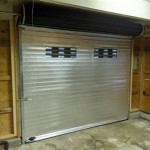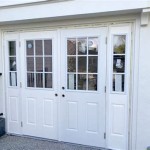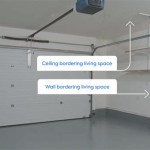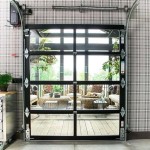Standard Garage Width for Two Cars: Understanding Dimensions and Planning
The determination of an appropriate garage width for two cars is a crucial consideration during home construction or renovation projects. It directly impacts the functionality, convenience, and overall satisfaction derived from the garage space. Understanding the factors influencing standard dimensions, as well as considering individual needs and preferences, is essential for informed decision-making.
The term "standard" in this context represents a range of commonly accepted dimensions, rather than a fixed, unyielding measurement. This range exists due to variations in vehicle size, architectural styles, and regional building codes. Therefore, a comprehensive understanding of these influencing factors is paramount before finalizing garage width specifications.
Defining Standard Two-Car Garage Width
The commonly cited "standard" width for a two-car garage typically falls between 20 and 24 feet. This range is predicated on providing adequate space for two average-sized vehicles to park side-by-side, allowing for comfortable entry and exit. However, this "standard" is a generalized approximation and should be treated as a starting point, not a definitive answer. Several factors can necessitate deviations from this range, warranting careful evaluation and customization.
To elaborate, a garage width of 20 feet might be considered the absolute minimum for accommodating two standard sedans or compact cars. However, this configuration often leaves minimal space for maneuvering around the vehicles, storing tools or equipment, or comfortably opening car doors without risking damage. A width closer to 24 feet provides significantly improved usability and flexibility, particularly for larger vehicles or homeowners who intend to use the garage for more than just parking.
Furthermore, the internal dimensions of the garage are more relevant than the external dimensions. Wall thickness, insulation, and finishing materials can all reduce the usable space within the garage. Consequently, plans should specify internal dimensions that meet the required parking and storage needs, taking into account the potential impact of construction materials.
Factors Influencing Optimal Garage Width
Several key factors contribute to determining the optimal garage width beyond the generalized "standard." These factors relate to vehicle size, individual needs, and existing or planned auxiliary uses for the garage space. A thorough assessment of these factors is essential for creating a functional and convenient garage environment.
The size of the vehicles that will occupy the garage is a primary consideration. Larger vehicles, such as trucks, SUVs, and vans, require significantly more width than compact cars. If the homeowners currently own or plan to own larger vehicles, a wider garage is essential to ensure comfortable parking and maneuvering. Accurate measurements of the vehicles, including the width with side mirrors extended, should be taken to inform the garage width decision.
Beyond vehicle size, the intended use of the garage space beyond parking influences the required width. If the garage will also serve as a workshop, storage area, or hobby space, additional width is necessary to accommodate workbenches, shelves, and equipment. Planning for sufficient circulation space around these areas is also crucial to maintain functionality and prevent overcrowding. It is recommended to create a detailed floor plan outlining the placement of vehicles, storage, and workspace to ensure adequate space allocation.
Architectural style and property limitations also play a role in determining feasible garage dimensions. Building codes and zoning regulations may impose restrictions on the size and placement of garages, requiring adherence to specific setbacks and height limitations. The overall aesthetic of the house and surrounding neighborhood should also be considered to ensure that the garage complements the existing architecture. Consultation with a qualified architect or builder is recommended to navigate these considerations and ensure compliance with all applicable regulations.
Specific Considerations for Garage Door Width
The garage door width is directly related to the overall garage width and must be carefully considered to ensure proper vehicle clearance and ease of access. The choice of garage door configuration – single door versus dual doors – further influences the dimensioning process. Understanding the relationship between garage width and garage door width is critical for optimal functionality.
For a standard two-car garage, it is common to use a single, wide garage door, typically ranging from 16 to 18 feet in width. This configuration allows both vehicles to enter and exit through a single opening, simplifying the access process. However, it also means that the failure of the garage door mechanism can render both vehicles unusable. Alternatively, two separate single-car garage doors, each around 8 to 9 feet wide, can be used. This configuration provides redundancy and allows one vehicle to be accessed even if the other door malfunctions.
Regardless of the chosen configuration, it is essential to ensure that the garage door width provides sufficient clearance for the vehicles, accounting for side mirrors, antennas, and any other protrusions. A minimum of 1 to 2 feet of clearance on each side of the vehicle is recommended to facilitate easy passage and prevent accidental damage. This clearance should be factored into the overall garage width calculation to ensure that the internal dimensions meet the required specifications.
Furthermore, the type of garage door opener mechanism can influence the required headroom within the garage. Overhead doors require adequate space for the tracks and motor, while side-mounted or roll-up doors may require less headroom. This should be factored into the overall garage design to ensure that the chosen door type can be accommodated without compromising usability.
Ultimately, determining the optimal garage width for two cars involves a careful consideration of vehicle size, storage needs, architectural constraints, and garage door configurations. While the "standard" range of 20 to 24 feet provides a general guideline, individual circumstances may necessitate deviations from this range. A thorough assessment of these factors, coupled with expert advice from architects and builders, ensures the creation of a functional, convenient, and aesthetically pleasing garage space that meets the specific needs of the homeowner.
Proper planning also includes consideration for future needs. While current vehicles may be of a certain size, future vehicle purchases should be considered, especially if the intention is to keep the garage for an extended period. Similarly, anticipating future storage needs or potential uses for the garage can help prevent the need for costly renovations later on.
In addition to width, garage depth should also be considered in conjunction with width to ensure ample space for vehicle parking and maneuvering. A standard depth of 20 to 24 feet is typically recommended, but this may need to be adjusted based on the length of the vehicles and the intended use of the garage space. A deeper garage allows for additional storage space in front of the vehicles or the possibility of incorporating a small workspace at the rear of the garage.
Finally, the placement of windows and pedestrian doors within the garage should be carefully planned to maximize natural light and provide convenient access. Windows should be positioned to provide adequate illumination without compromising security or privacy. Pedestrian doors should be located to allow easy access to the house or yard without requiring the garage door to be opened.

Designing Your Dream Garage Exploring The Dimensions Of A 2 Car

Standard Garage Dimensions For 1 2 3 And 4 Car Garages Diagrams

2 Car Garage Dimensions Your Complete Guide

What Garage Size Do I Need Danley S Garages

An Introduction To Garage Door Sizes Continental

Standard Garage Sizes Examples

Standard Garage Dimensions And Measurements By Length Width Height

Standard Garage Sizes Examples

Standard Garage Door Sizes And Considerations Spectrum Ohd

Double Garage Dimensions Your Ezfeasy Guide For The Right Size








